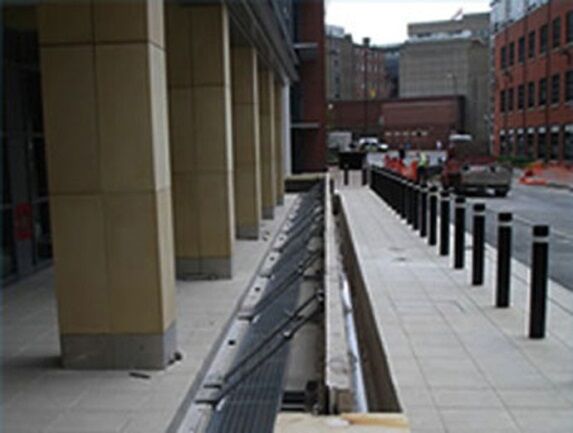Flood Barriers
Install Permanent Flood Barriers: Passive Barriers
What Is It?

Tilt-Dam
Temporary flood barriers are effective, but require time and labor to deploy. Depending on site conditions and frequency of flooding, it may be more cost effective in the long-term to install a permanent, in-situ flood barrier. There are many permanent flood barrier options that are passive, recessed into a site, and require no deployment. In some cases, hydrostatic pressure from rising floodwaters causes flood barriers to rise from a recessed location until the barrier is fully upright and automatically sealed. Some products (e.g. Aquafragma) will issue warnings before deployment occurs. Other permanent barriers require human intervention, but often have shorter deployment times than temporary barriers. Permanent barriers will easily deploy and retract until end of service life with less setup and cleanup required than temporary barriers. Retractable permanent barriers can be combined with other permanent flood barriers (e.g. flood walls). The retractable barriers can be installed in gaps and entrances in the flood walls to allow for building access and mobility until rising floodwaters necessitate deployment of the retractable barrier.
Regular maintenance will be necessary to ensure the barrier is ready for deployment when a flood occurs, though maintenance will vary depending on the type of barrier installed. As permanent retractable barriers are often recessed into the ground until deployment, installation in existing sites will require construction and excavation. Non-passive barriers will typically require shallower foundations, lowering excavation costs. Consulting an engineer to determine optimal siting and certify structural integrity should also be considered; some suppliers (i.e. FloodBreak) include engineer certification in every purchase.
Benefits
- Passive barriers minimize human intervention in many areas, including deployment, demounting, and storage, as well as needs for training personnel. Permanent barriers that are not passive often still have lower deployment times and human intervention needs to deploy.
- Passive barriers do not use electricity, allowing for constant flood protection.
- Passive barriers do not need to be deployed ahead of a flood event. This provides protection against flash floods while also allowing site access until flood waters reach the building site.
- Passive barriers are installed onsite and are typically custom-sized for the site’s needs.
- Recessed permanent barriers can be modified to minimize disruption to building aesthetics.
- Passive barriers are preferred by FEMA as a best management practice for flood mitigation.
Drawbacks
- Onsite construction and excavation are usually needed to install permanent barriers.
- Upfront costs, especially for barriers requiring on-site construction, will be significantly higher than temporary barriers and flood shields.
- Due to higher costs, passive barriers usually need to be combined with other site protection (e.g. flood walls) to maximize effectiveness for larger sites.
Regulatory Impacts and Requirements
Potential regulatory touchpoints in Boston and Massachusetts include:
- Fire Department
- Building Code/Permit
- Inspectional Services Department
Financing Options, Incentives, and Rebates
- FEMA Hazard Mitigation Assistance– FEMA provides funding for flood and disaster mitigation through three grant programs:
- Hazard Mitigation Grant Program,
- Pre-Disaster Mitigation
- Flood Mitigation Assistance
- Additional information and application instructions are available here through the Massachusetts Emergency Management Agency. Only non-residential dry floodproofing projects are eligible.
- Hazard Mitigation Funding Under Section 406 of the Stafford Act – Local, state, tribal, and some non-profit facilities damaged by disasters may use Section 406 funding to restore damaged facilities, as well as undertake preventative measures for future flood mitigation.
NEWS
- "Venice's Vast New Flood Barrier Is Almost Here" CityLab, September 2016
- "New York Has a New $20 Billion Plan to Protect Itself from the Next Super Storm" Coexist, June 2013
RESOURCES
- FEMA, “Floodproofing Non-Residential Buildings” (2013): http://www.fema.gov/media-library-data/300a860542ae1e7cdfcf3a11abcb7fde/P-936_sec1_508.pdf
PROJECT EXAMPLES
- Lourdes Hospital, NY: 11 FloodBreak passive floodgates combined with 11-foot floodwall at a cost of approx. $7 million
- Vulcan House Iron in Sheffield, UK: 96m of Tilt-Dam installed. Included surface finishing to match existing aesthetics.
- Route 22 Honda, NJ: Single FloodBreak passive floodgate installed in front of underground garage showroom entrance. Successful deployment and protection in two flood events resulted in reduction of insurance deductible from $100,000 to $10,000.
- Kensington Gate, NY: Floodbreak passive vehicle gate that has experienced 8 saves since installation in 2008.


